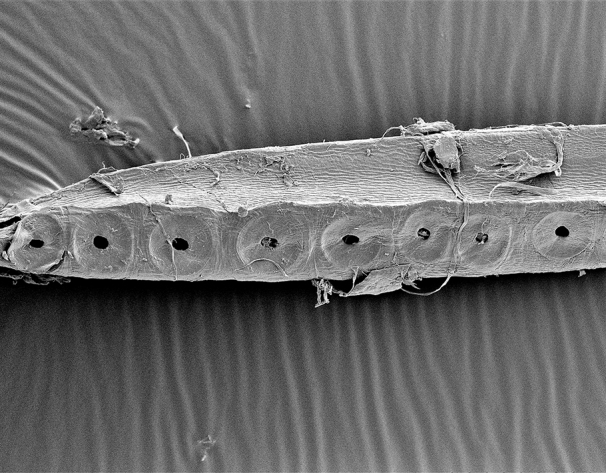Hua Zhang:
ORCID: https://orcid.org/0000-0002-5871-8264
Role: ConceptualizationRole: Funding acquisitionRole: InvestigationRole: MethodologyRole:
Project administrationRole: ResourcesRole: ValidationRole: Writing - original draftRole:
Writing - review & editing
Feifei Zhang:
ORCID: https://orcid.org/0000-0003-3277-445X
Role: MethodologyRole: VisualizationRole: Writing - original draftRole: Writing -
review & editing
Jiu-bin Chen:
ORCID: https://orcid.org/0000-0001-7299-0355
Role: ConceptualizationRole: Data curationRole: Formal analysisRole: Funding acquisitionRole:
InvestigationRole: MethodologyRole: ResourcesRole: ValidationRole: VisualizationRole:
Writing - original draftRole: Writing - review & editing
Douglas H. Erwin:
ORCID: https://orcid.org/0000-0003-2518-5614
Role: ConceptualizationRole: InvestigationRole: VisualizationRole: Writing - original
draftRole: Writing - review & editing
Drew D. Syverson:
ORCID: https://orcid.org/0000-0003-2838-1522
Role: ConceptualizationRole: Formal analysisRole: InvestigationRole: MethodologyRole:
VisualizationRole: Writing - review & editing
Pei Ni: Role: ConceptualizationRole: InvestigationRole: MethodologyRole: ValidationRole: VisualizationRole:
Writing - original draftRole: Writing - review & editing
Michael Rampino: Role: ConceptualizationRole: InvestigationRole: ValidationRole: Writing - original
draftRole: Writing - review & editing
Zhe Chi: Role: InvestigationRole: Writing - original draft
Yao-feng Cai: Role: InvestigationRole: Visualization
Lei Xiang: Role: InvestigationRole: Resources
Wei-qiang Li:
ORCID: https://orcid.org/0000-0003-2648-7630
Role: Writing - review & editing
Sheng-Ao Liu: Role: InvestigationRole: Methodology
Ru-cheng Wang:
ORCID: https://orcid.org/0000-0002-2076-5073
Role: Investigation
Xiang-dong Wang: Role: Investigation
Zhuo Feng:
ORCID: https://orcid.org/0000-0001-9635-1144
Role: ConceptualizationRole: Funding acquisition
Hou-min Li: Role: InvestigationRole: Resources
Ting Zhang:
ORCID: https://orcid.org/0000-0003-1356-3200
Role: Formal analysisRole: InvestigationRole: ResourcesRole: Validation
Hong-ming Cai: Role: Formal analysisRole: InvestigationRole: ResourcesRole: ValidationRole: Writing
- original draftRole: Writing - review & editing
Wang Zheng:
ORCID: https://orcid.org/0000-0002-3413-9700
Role: VisualizationRole: Writing - original draftRole: Writing - review & editing
Ying Cui: Role: Formal analysisRole: Methodology
Xiang-kun Zhu: Role: ConceptualizationRole: Writing - review & editing
Zeng-qian Hou: Role: InvestigationRole: Writing - review & editing
Fu-yuan Wu: Role: ConceptualizationRole: InvestigationRole: MethodologyRole: VisualizationRole:
Writing - original draftRole: Writing - review & editing
Yi-gang Xu: Role: ConceptualizationRole: InvestigationRole: MethodologyRole: Writing - review
& editing
Noah Planavsky:
ORCID: https://orcid.org/0000-0001-5849-8508
Role: ConceptualizationRole: Formal analysisRole: Methodology
Shu-zhong Shen:
ORCID: https://orcid.org/0000-0001-8380-0692
Role: ConceptualizationRole: Data curationRole: Funding acquisitionRole: InvestigationRole:
MethodologyRole: Project administrationRole: ResourcesRole: SupervisionRole: ValidationRole:
VisualizationRole: Writing - original draftRole: Writing - review & editing
Journal ID (nlm-ta): Sci Adv
Journal ID (iso-abbrev): Sci Adv
Journal ID (publisher-id): sciadv
Journal ID (hwp): advances
Title:
Science Advances
Publisher:
American Association for the Advancement of Science
ISSN
(Electronic):
2375-2548
Publication date Collection:
November
2021
Publication date
(Electronic, pub):
17
November
2021
Volume: 7
Issue: 47
Electronic Location Identifier: eabh1390
Affiliations
[1
]LPS, Nanjing Institute of Geology and Palaeontology and Center for Excellence in Life
and Paleoenvironment, Chinese Academy of Sciences, Nanjing 210008, China.
[2
]State Key Laboratory for Mineral Deposits Research, School of Earth Sciences and Engineering
and Environment and Frontiers Science Center for Critical Earth Material Cycling,
Nanjing University, Nanjing 210023, China.
[3
]Institute of Surface-Earth System Science, Tianjin University, 92 Weijin Road, Tianjin
300072, China.
[4
]Department of Paleobiology, MRC-121 National Museum of Natural History, P.O. Box 37012,
Washington, DC 20013-7012, USA.
[5
]Santa Fe Institute, 1399 Hyde Park Road, Santa Fe, NM 87501, USA.
[6
]Department of Earth and Planetary Sciences, Yale University, New Haven, CT 06511,
USA.
[7
]Departments of Biology and Environmental Studies, New York University, New York, NY
10003, USA.
[8
]State Key Laboratory of Geological Processes and Mineral Resources, China University
of Geosciences, Beijing 100083, China.
[9
]Institute of Deep Time Terrestrial Ecology and Institute of Palaeontology, Yunnan
University, Kunming 650500, China.
[10
]Institute of Geology, Chinese Academy of Geological Sciences, Beijing 100037, China.
[11
]Department of Earth and Environmental Studies, Montclair State University, Montclair,
NJ 07043, USA.
[12
]State Key Laboratory of Lithospheric Evolution, Institute of Geology and Geophysics,
Chinese Academy of Sciences, Beijing 100029, China.
[13
]State Key Laboratory of Isotope Geochemistry and Center of Excellence in Deep Earth
Science, Guangzhou Institute of Geochemistry, Chinese Academy of Sciences, Guangzhou
510640, China.
[14
]Key Laboratory of Continental Collision and Plateau Uplift, Institute of Tibetan Plateau
Research and Center for Excellence in Tibetan Plateau Earth Sciences, Chinese Academy
of Sciences, Beijing 100101, China.
Author notes
Author information
Article
Publisher ID:
abh1390
DOI: 10.1126/sciadv.abh1390
PMC ID: 8597993
PubMed ID: 34788084
SO-VID: 4723f280-a37a-4dd2-935e-e070b219ebc8
Copyright © Copyright © 2021 The Authors, some rights reserved; exclusive licensee American Association
for the Advancement of Science. No claim to original U.S. Government Works. Distributed
under a Creative Commons Attribution NonCommercial License 4.0 (CC BY-NC).
License:
This is an open-access article distributed under the terms of the
Creative Commons Attribution-NonCommercial license, which permits use, distribution, and reproduction in any medium, so long as the
resultant use is
not for commercial advantage and provided the original work is properly cited.
Funded by:
FundRef http://dx.doi.org/10.13039/501100001809, National Natural Science Foundation of China;
Award ID: U1702242
Funded by:
FundRef http://dx.doi.org/10.13039/501100001809, National Natural Science Foundation of China;
Award ID: 91955201
Funded by:
FundRef http://dx.doi.org/10.13039/501100001809, National Natural Science Foundation of China;
Award ID: 41625012
Funded by:
FundRef http://dx.doi.org/10.13039/501100001809, National Natural Science Foundation of China;
Award ID: 41961144028
Funded by:
FundRef http://dx.doi.org/10.13039/501100002367, Chinese Academy of Sciences;
Award ID: XDB18000000
Funded by:
FundRef http://dx.doi.org/10.13039/501100002367, Chinese Academy of Sciences;
Award ID: XDB26000000
Funded by:
FundRef http://dx.doi.org/10.13039/501100002367, Chinese Academy of Sciences;
Award ID: QYZDYSSW-DQC023
Funded by:
Second Tibetan Plateau Scientific Expedition and Research;
Award ID: 2019QZKK0706
Funded by:
Ministry of Education of China;
Award ID: 0206-14380125, DLTD2102

